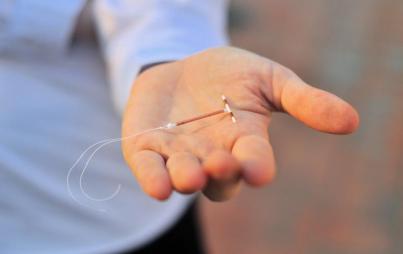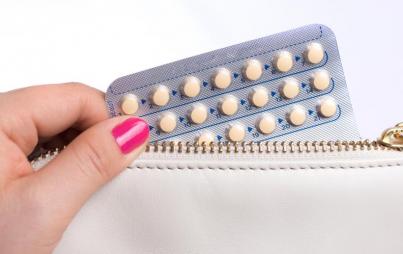
Four million humans burst from the womb onto our little blue planet every year, but three million of those births are unintended. Crazier still? More than half of all those we're-not-so-sure pregnancies occur with women who are using contraception.
I mean, holy shit people. These stats raise questions about everything from sex education and the correct use of contraception to reproductive rights and population problems.
Freud was right. Sex is at the crux of the whole damn world.
Sadly, these harrowing numbers are nothing new. In fact, they represent leaps and bounds in our ability to counter teen pregnancy and unwanted births, and to foster ground-up knowledge of how our bodies work. While the pill was an undeniable lynchpin in women's sexual freedom and reproductive rights—it was at the epicenter of the Free Love movement that lay the foundation for modern-day sexual mores—it seems we should have been using the IUD (intrauterine device) instead. It could have saved millions of women from bringing unwanted children into this world and of course, millions of lives snuffed out by abortions.
So what the hell happened?
A Quick and Dirty History
While the IUD emerged hot on the heels of oral contraception and was quickly adopted by 10% of the female American population (no hormones! no having to remember to swallow a pill!) by the early 1970s, the Dalkan Shield IUD soon collapsed under the weight of (possible) misinformation and dubious lawsuits, dragging down every IUD in its wake. More than 200,000 women filed claims against the A.H. Robins Company, which had sold the product to about 2.5 million ladies during a four-year period.
The crux of the lawsuits? Septic abortions and pelvic inflammatory disease. Doctors now believe that the string attached to the t-shaped object was enabling bacteria to creep up into the uterus. The FDA strong-armed the company into halting production and by 1984, the FDA publicly stated that any women with the device should have it removed.
The culpability of the Dalkan Shield for these occurrences is still incredibly nebulous. In a 1987 New York Times article, Dr. Nancy Lee of the CDC explained that Pelvic inflammatory disease ''can be caused by a multitude of organisms, some that are sexually transmitted and others from a woman's own body.''
No scientist can say with certainty that a woman who wore the shield and subsequently developed pelvic inflammatory disease contracted it because of the shield. It is impossible to rule out other possible causes of the infection. — Gina Kolata, New York Times
In short? It was a fucking disaster for reliable contraception that America is still reeling from. Although myriad incarnations of much safer IUD models were designed and marketed, the IUD has never recovered its reputation despite its superiority over the majority of contraceptive options.
A 2010 survey of Fellows of the American College of Obstreticians and Gynecologists was conducted to observe the complicated obstacles to IUD adoption, including provider and patient misinformation, high upfront costs and clinician practice patterns. (And yes, of course I have my own conspiratorial theories on the pharmaceutical industry systematically coercing women into buyin' those pills every month.)
IUD by the Numbers
* IUDs have failure rates of less than 1% (compared to the pill's 6%, or the ring's 9%.)
* 95% of obstetricians and gynecologists agreed the IUD was safe, but at the time? Only 1.3% of women were using it. The numbers have recently "skyrocketed" to an all-time high of 10%.
* The U.S. IUD rates are significantly lower than many European and Asian countries: 27% in Norway and 30% in China
* The St. Louis OBGYNs that were surveyed said: 97.8% would offer IUD to a 35-year-old patient who was married, monogamous and had three children; 67.1% would offer an IUD to a 30-year-old who was unmarried, had two children and had a boyfriend; 49.6% would offer an IUD to a 17-year-old who was unmarried, monogamous and had one child.
* Shockingly, only 19% would be willing to offer IUD to an unmarried 17-year-old who had never been pregnant. Which is exactly the demographic we should be targeting.
The IUD costs at most, about $1,000 to implement, but lasts up to 12 years(!); not surprisingly, Planned Parenthood has stepped directly into the fray and has begun touting the method highly in recent years, dramatically influencing the way women are relating ot their bodies.
From 2011-2012, we saw a 19 percent increase in IUD patients. Since 2008, it’s gone up 75 percent. IUDs are the number-one method of birth control for OB/GYNs. More and more, patients come in because their friends suggest it after getting one themselves. Provider education and professional organizations are working on awareness. — Karen Shea, Planned Parenthood Federation of America Director of Medical Standards.
It seems we're finally on the cusp of a (dare-we-utter-the-words) solution for pregnancy problems that have plagued women for centuries. We're crossing our fingers, toes and eyes that this trend continues.
Image: ThinkStock






